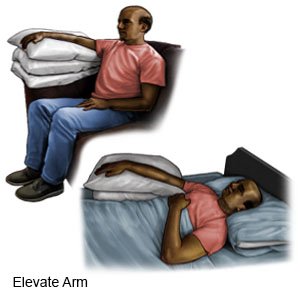Arm Pain
Medically reviewed by Drugs.com. Last updated on Apr 6, 2025.
Your arm pain may be caused by a number of conditions. Examples include arthritis, nerve problems, or an awkward position while you sleep. X-rays did not show a broken bone in your arm or wrist. Arm pain may be a sign of a serious condition that needs immediate care, such as a heart attack.
DISCHARGE INSTRUCTIONS:
Call your local emergency number (911 in the US) for any of the following:
- You have any of the following signs of a heart attack:
- Squeezing, pressure, or pain in your chest
- You may also have any of the following:
- Discomfort or pain in your back, neck, jaw, stomach, or arm
- Shortness of breath
- Nausea or vomiting
- Lightheadedness or a sudden cold sweat
Return to the emergency department if:
- You have severe pain, or pain that spreads from your arm to other areas.
- You have swelling, tingling, or numbness in your hand or fingers, or the skin turns blue.
- You cannot move your arm.
Drugs used to treat this and similar conditions
Qutenza
Qutenza patches are used to treat neuropathic pain associated with postherpetic neuralgia and ...
L-Carnitine
L-Carnitine is used for carnitine deficiency, peripheral neuropathy
Repatha
Repatha (evolocumab) is a PCSK9 inhibitor used to lower high cholesterol alongside dietary changes ...
Carnitor
Carnitor is used for carnitine deficiency, peripheral neuropathy
Carnitor SF
Carnitor SF is used for carnitine deficiency, peripheral neuropathy
Phenytoin
Phenytoin is an anti-epileptic drug, also called an anticonvulsant. Learn about side effects ...
Capsaicin topical
Capsaicin information from Drugs.com, includes Capsaicin side effects, interactions and indications.
Carbamazepine
Carbamazepine is used to treat epileptic seizures and nerve pain such as trigeminal neuralgia ...
Levocarnitine
Levocarnitine systemic is used for carnitine deficiency, peripheral neuropathy
Pregabalin
Pregabalin may be used to treat certain types of pain and used in combination with other ...
Treatment options
The following list of medications are related to or used in the treatment of this condition.
Call your doctor if:
- You have questions or concerns about your condition or care.
Medicines:
You may need any of the following:
- Prescription pain medicine may be given. Ask your healthcare provider how to take this medicine safely. Some prescription pain medicines contain acetaminophen. Do not take other medicines that contain acetaminophen without talking to your healthcare provider. Too much acetaminophen may cause liver damage. Prescription pain medicine may cause constipation. Ask your healthcare provider how to prevent or treat constipation.
- NSAIDs , such as ibuprofen, help decrease swelling, pain, and fever. This medicine is available with or without a doctor's order. NSAIDs can cause stomach bleeding or kidney problems in certain people. If you take blood thinner medicine, always ask your healthcare provider if NSAIDs are safe for you. Always read the medicine label and follow directions.
- Take your medicine as directed. Contact your healthcare provider if you think your medicine is not helping or if you have side effects. Tell your provider if you are allergic to any medicine. Keep a list of the medicines, vitamins, and herbs you take. Include the amounts, and when and why you take them. Bring the list or the pill bottles to follow-up visits. Carry your medicine list with you in case of an emergency.
Self-care:
- Rest your arm as directed. A sling may be used to keep your arm from moving while it heals.
- Apply ice as directed. Ice helps decrease pain and swelling. Ice may also help prevent tissue damage. Use an ice pack, or put crushed ice in a plastic bag. Cover it with a towel. Apply it to your arm for 20 minutes every few hours, or as directed. Ask how many times to apply ice each day, and for how many days.
- Elevate your arm above the level of your heart as often as you can. This will help decrease swelling and pain. Prop your arm on pillows or blankets to keep the area elevated comfortably.

- Adjust your position if you work in front of a computer. You may need arm or wrist supports or change the height of your chair.
- Keep a pain record. Write down when your pain happens and how severe it is. Include any other symptoms you have with your pain. A record will help you keep track of pain cycles. Bring the record with you to your follow-up visits. It may also help your healthcare provider find out what is causing your pain.
Follow up with your doctor as directed:
You may need physical therapy. You may need to see an orthopedic specialist. Write down your questions so you remember to ask them during your visits.
© Copyright Merative 2025 Information is for End User's use only and may not be sold, redistributed or otherwise used for commercial purposes.
The above information is an educational aid only. It is not intended as medical advice for individual conditions or treatments. Talk to your doctor, nurse or pharmacist before following any medical regimen to see if it is safe and effective for you.
Learn more about Arm Pain
Treatment options
Care guides
- Acetaminophen and Ibuprofen Dosing in Children
- Back Pain
- Fibromyalgia
- Hip Pain
- Musculoskeletal Pain
- Shoulder Pain
- Viral Syndrome in Children
Medicine.com guides (external)
Further information
Always consult your healthcare provider to ensure the information displayed on this page applies to your personal circumstances.
